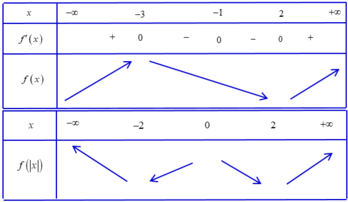
Hãy nhập câu hỏi của bạn vào đây, nếu là tài khoản VIP, bạn sẽ được ưu tiên trả lời.


2: ĐKXĐ: x<>1
\(f'\left(x\right)=\dfrac{\left(x^2-3x+3\right)'\left(x-1\right)-\left(x^2-3x+3\right)\left(x-1\right)'}{\left(x-1\right)^2}\)
\(=\dfrac{\left(2x-3\right)\left(x-1\right)-\left(x^2-3x+3\right)}{\left(x-1\right)^2}\)
\(=\dfrac{2x^2-5x+3-x^2+3x-3}{\left(x-1\right)^2}=\dfrac{x^2-2x}{\left(x-1\right)^2}\)
f'(x)=0
=>x^2-2x=0
=>x(x-2)=0
=>\(\left[{}\begin{matrix}x=0\\x=2\end{matrix}\right.\)
1:
\(f\left(x\right)=\dfrac{1}{3}x^3-2\sqrt{2}\cdot x^2+8x-1\)
=>\(f'\left(x\right)=\dfrac{1}{3}\cdot3x^2-2\sqrt{2}\cdot2x+8=x^2-4\sqrt{2}\cdot x+8=\left(x-2\sqrt{2}\right)^2\)
f'(x)=0
=>\(\left(x-2\sqrt{2}\right)^2=0\)
=>\(x-2\sqrt{2}=0\)
=>\(x=2\sqrt{2}\)

1. Áp dụng quy tắc L'Hopital
\(\lim\limits_{x\rightarrow0}\dfrac{\sqrt{x+1}-1}{f\left(0\right)-f\left(x\right)}=\lim\limits_{x\rightarrow0}\dfrac{\dfrac{1}{2\sqrt{x+1}}}{-f'\left(0\right)}=-\dfrac{1}{6}\)
2.
\(g'\left(x\right)=2x.f'\left(\sqrt{x^2+4}\right)=0\Rightarrow\left[{}\begin{matrix}x=0\\f'\left(\sqrt{x^2+4}\right)=0\end{matrix}\right.\)
\(\Leftrightarrow\left[{}\begin{matrix}x=0\\\sqrt{x^2+4}=1\\\sqrt{x^2+4}=-2\end{matrix}\right.\)
2 pt cuối đều vô nghiệm nên \(g'\left(x\right)=0\) có đúng 1 nghiệm

1: \(f'\left(x\right)=\dfrac{1}{3}\cdot3x^2+2x-\left(m+1\right)=x^2+2x-m-1\)
\(\Delta=2^2-4\left(-m-1\right)=4m+8\)
Để f'(x)>=0 với mọi x thì 4m+8<=0 và 1>0
=>m<=-2
=>\(m\in\left\{-10;-9;...;-2\right\}\)
=>Có 9 số

1) \(f\left(x\right)=2x-5\)
\(f'\left(x\right)=2\)
\(\Rightarrow f'\left(4\right)=2\)
2) \(y=x^2-3\sqrt[]{x}+\dfrac{1}{x}\)
\(\Rightarrow y'=2x-\dfrac{3}{2\sqrt[]{x}}-\dfrac{1}{x^2}\)
3) \(f\left(x\right)=\dfrac{x+9}{x+3}+4\sqrt[]{x}\)
\(\Rightarrow f'\left(x\right)=\dfrac{1.\left(x+3\right)-1.\left(x+9\right)}{\left(x-3\right)^2}+\dfrac{4}{2\sqrt[]{x}}\)
\(\Rightarrow f'\left(x\right)=\dfrac{x+3-x-9}{\left(x-3\right)^2}+\dfrac{2}{\sqrt[]{x}}\)
\(\Rightarrow f'\left(x\right)=\dfrac{12}{\left(x-3\right)^2}+\dfrac{2}{\sqrt[]{x}}\)
\(\Rightarrow f'\left(x\right)=2\left[\dfrac{6}{\left(x-3\right)^2}+\dfrac{1}{\sqrt[]{x}}\right]\)
\(\Rightarrow f'\left(1\right)=2\left[\dfrac{6}{\left(1-3\right)^2}+\dfrac{1}{\sqrt[]{1}}\right]=2\left(\dfrac{3}{2}+1\right)=2.\dfrac{5}{2}=5\)

1/ \(y'=\dfrac{\left(\sqrt{x+1}\right)'x-x'\sqrt{x+1}}{x^2}=\dfrac{\dfrac{x}{2\sqrt{x+1}}-\sqrt{x+1}}{x^2}=\dfrac{-x-2}{2x^2\sqrt{x+1}}\)
2/ \(y'=\dfrac{1-x^2-\left(1-x^2\right)'x}{\left(1-x^2\right)^2}=\dfrac{1+x^2}{\left(1-x^2\right)^2}\)
3/ \(y'=\dfrac{-\left(x-\sqrt{x+1}\right)'}{\left(x-\sqrt{x+1}\right)^2}=\dfrac{-1+\dfrac{1}{2\sqrt{x+1}}}{\left(x-\sqrt{x+1}\right)^2}\)
4/ \(y'=f'\left(x\right)=2x-\dfrac{2x}{x^4}=2x-\dfrac{2}{x^3}\)
\(y'=0\Leftrightarrow\dfrac{2x^4-2}{x^3}=0\Leftrightarrow x=\pm1\)
5/ \(y'=\dfrac{\dfrac{1}{2\sqrt{1+x}}}{2\sqrt{1+\sqrt{1+x}}}\Rightarrow f\left(x\right).f'\left(x\right)=\sqrt{1+\sqrt{1+x}}.\dfrac{1}{4\sqrt{1+x}.\sqrt{1+\sqrt{1+x}}}=\dfrac{1}{4\sqrt{1+x}}=\dfrac{1}{2\sqrt{2}}\)
\(\Leftrightarrow2\sqrt{1+x}=\sqrt{2}\Leftrightarrow1+x=\dfrac{1}{2}\Leftrightarrow x=-\dfrac{1}{2}\)
Hãy nhớ câu tính đạo hàm này, bởi nó liên quan đến nguyên hàm sau này sẽ học








Chọn A.
Với x = 1 ta có f(1) = k2
Với x ≠ 1 ta có
suy ra .
.
Vậy để hàm số gián đoạn tại x = 1 khi ⇔ k2 ≠ 4 ⇔ k ≠ ±2.
⇔ k2 ≠ 4 ⇔ k ≠ ±2.